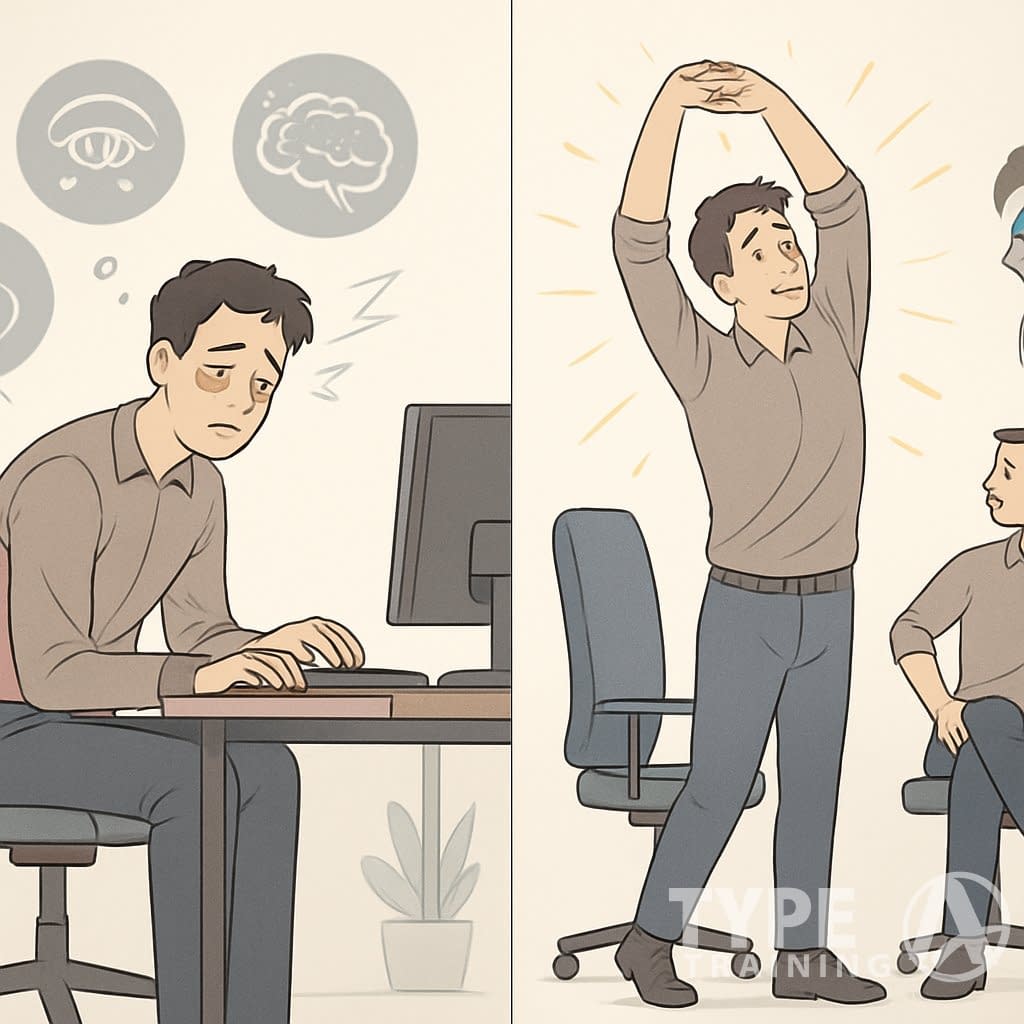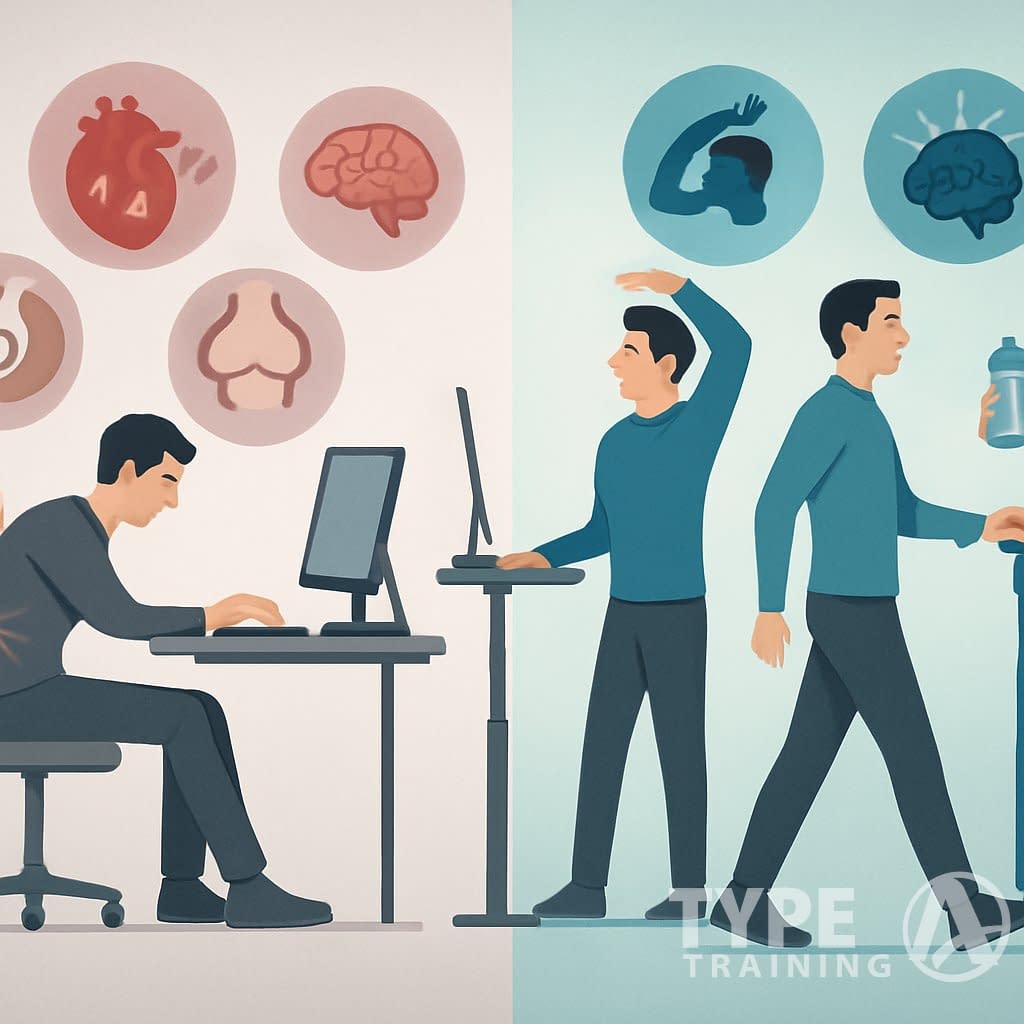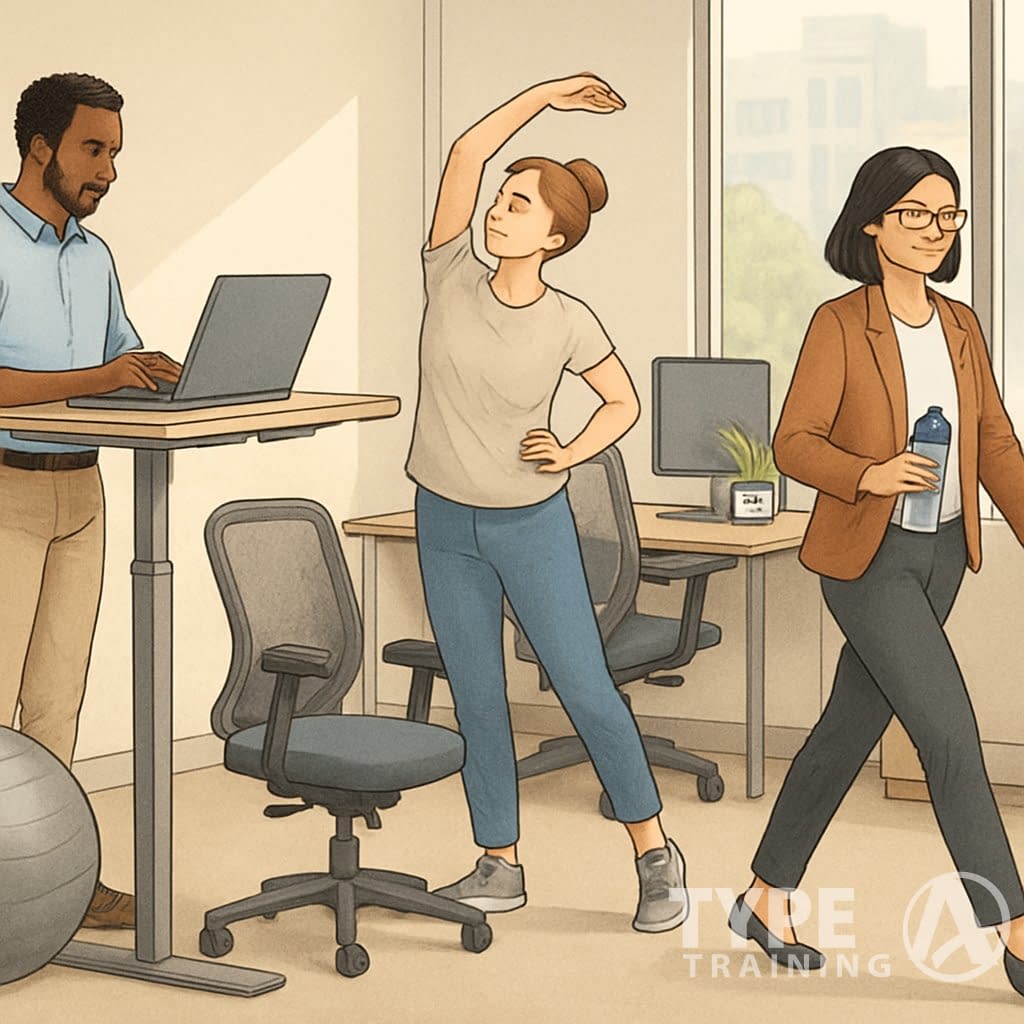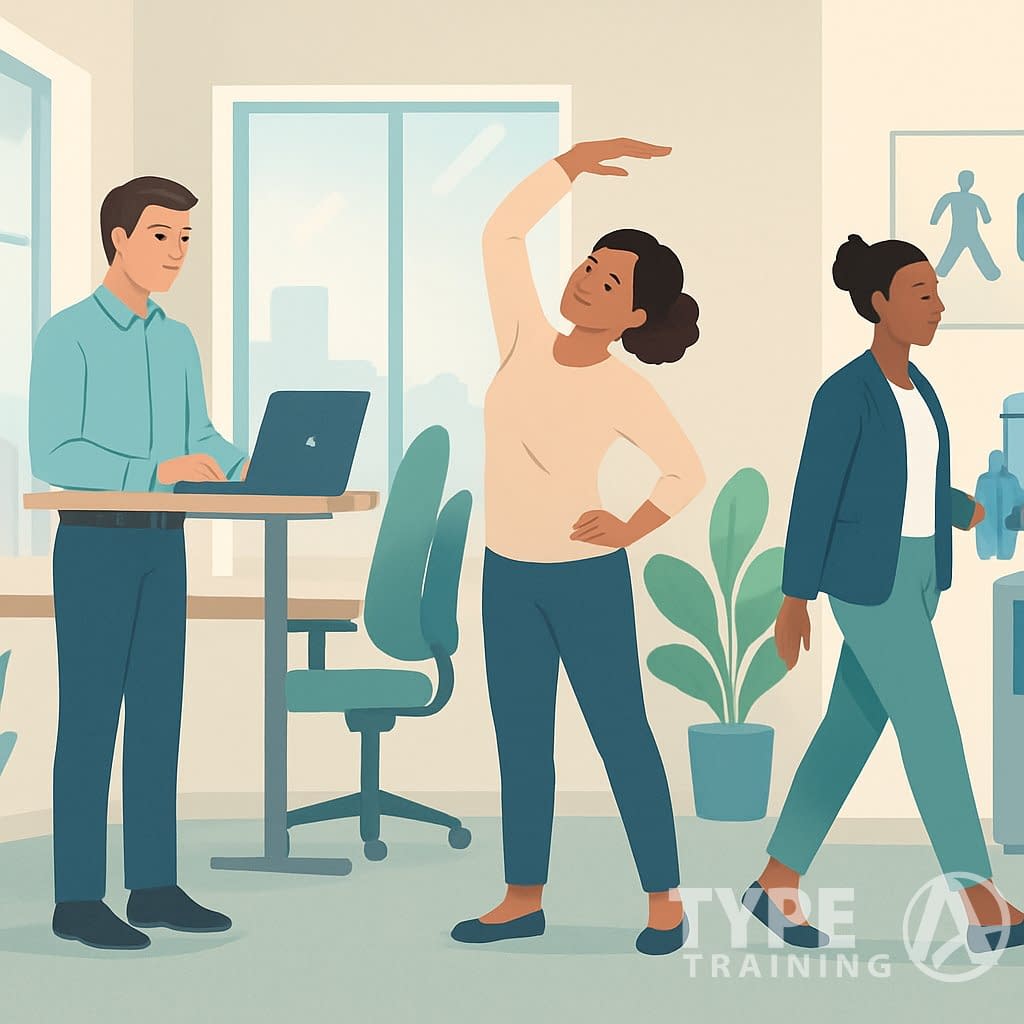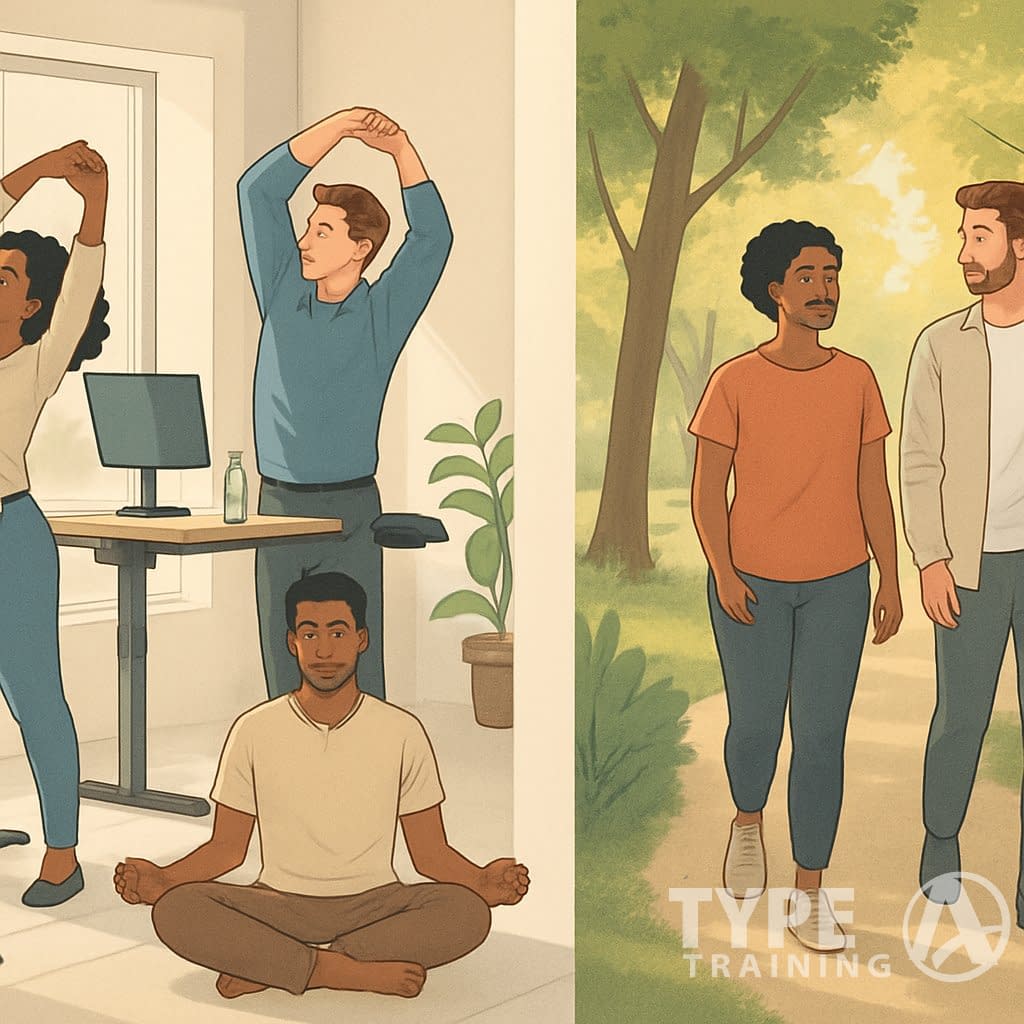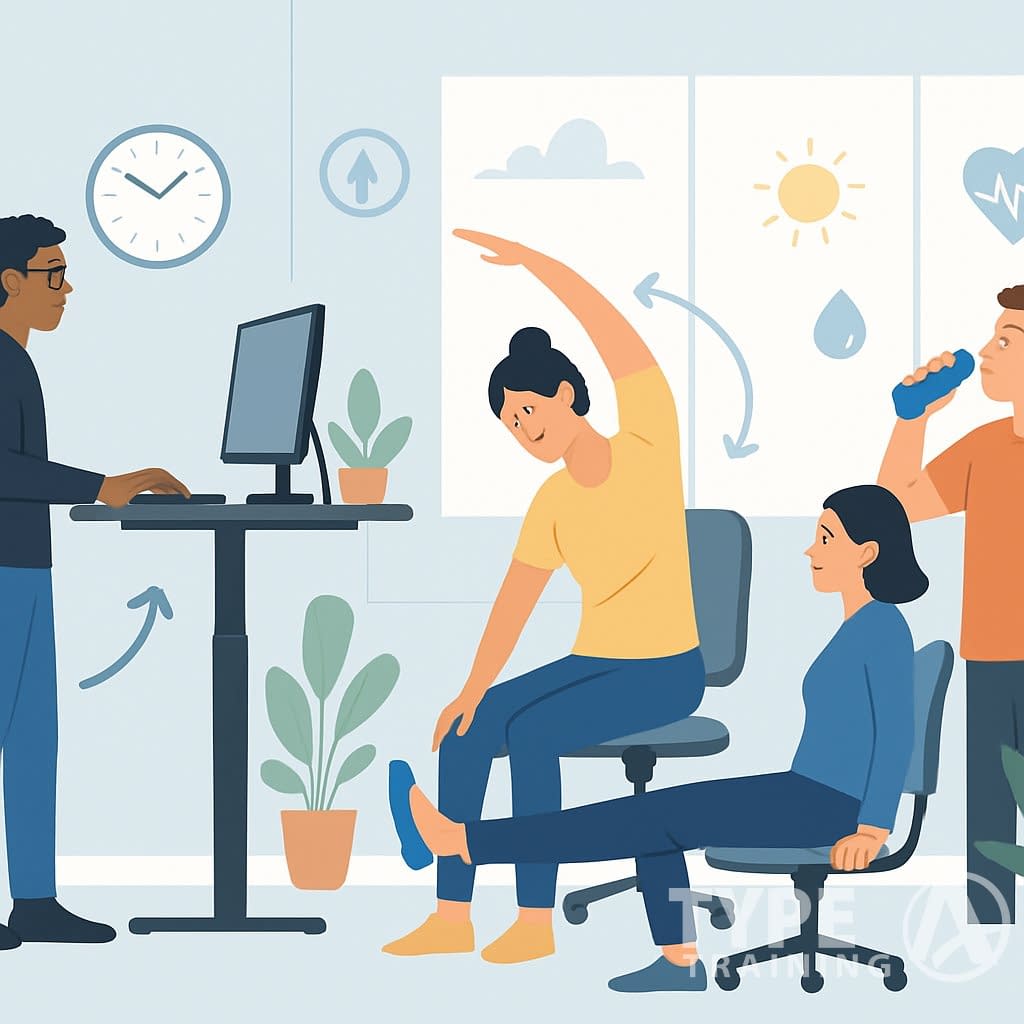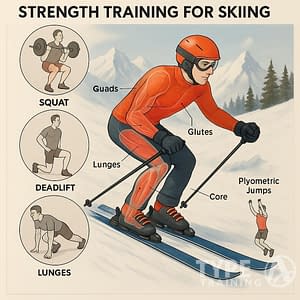Most people spend over half their waking hours sitting—at work, commuting, or just relaxing at home. This modern lifestyle brings real health challenges that affect millions everywhere.
Understanding the effects of prolonged sitting is crucial for maintaining a healthy lifestyle.
Your body just isn’t built to stay in one position for hours.
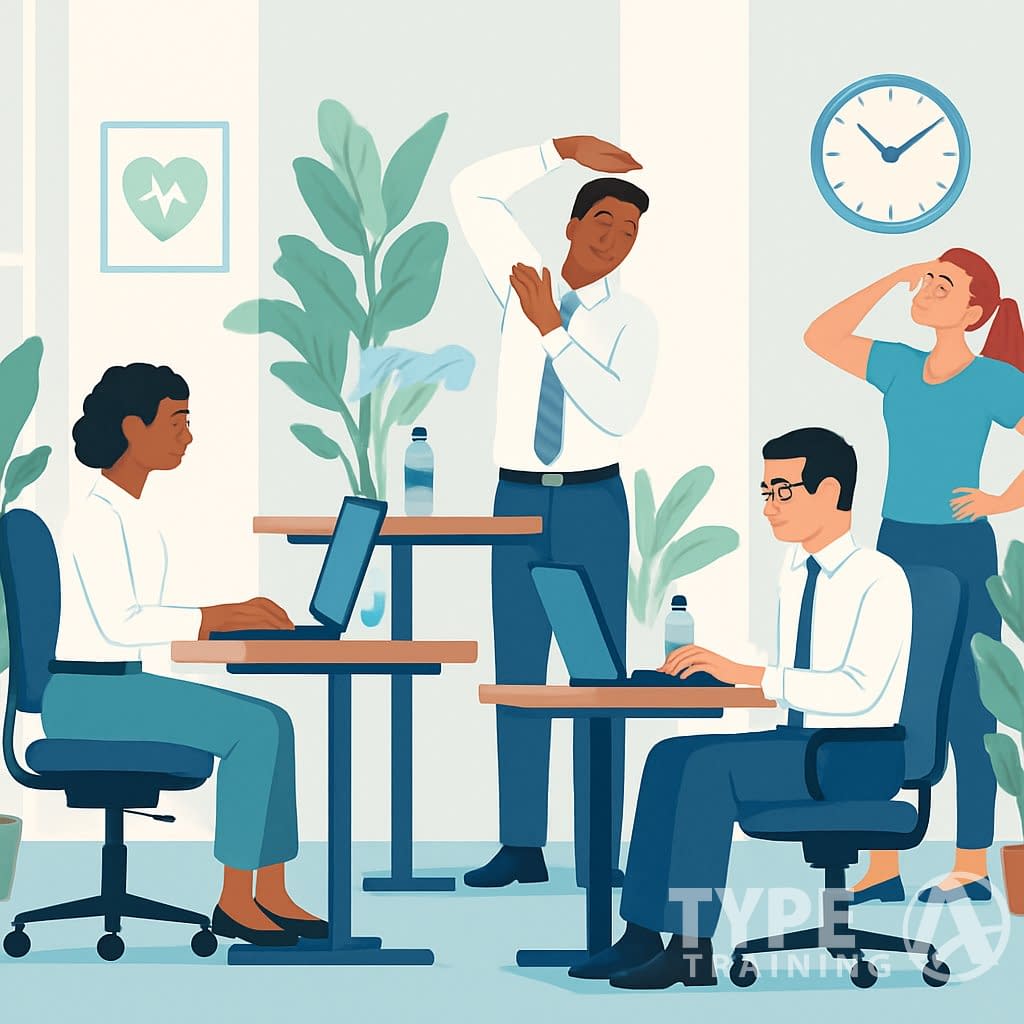
Popular posts:
Breaking up sitting time with just 5-minute walks every 30 minutes can significantly reduce blood sugar levels and
Recent studies show that any movement during long sitting periods helps counter the negative effects on your heart, metabolism, and mental health.
Recognizing the effects of prolonged sitting allows individuals to take proactive steps towards better health.
You don’t have to overhaul your lifestyle to see real benefits. Small actions throughout your day can make a surprisingly big difference.
If you understand what sitting does to your body and pick up a few simple strategies, you can take control of your well-being.
Key Takeaways
-
- Sitting for long periods increases your risk of heart disease, diabetes, and other serious health problems.
- Taking short walking breaks every 30 minutes can reverse many negative effects of prolonged sitting.
Incorporating movement can mitigate the effects of prolonged sitting and promote overall well-being.
- Simple daily habits like standing meetings and desk exercises can improve your physical and mental health.
Understanding Prolonged Sitting and Its Widespread Impact
Awareness of the effects of prolonged sitting can empower you to make healthier choices.
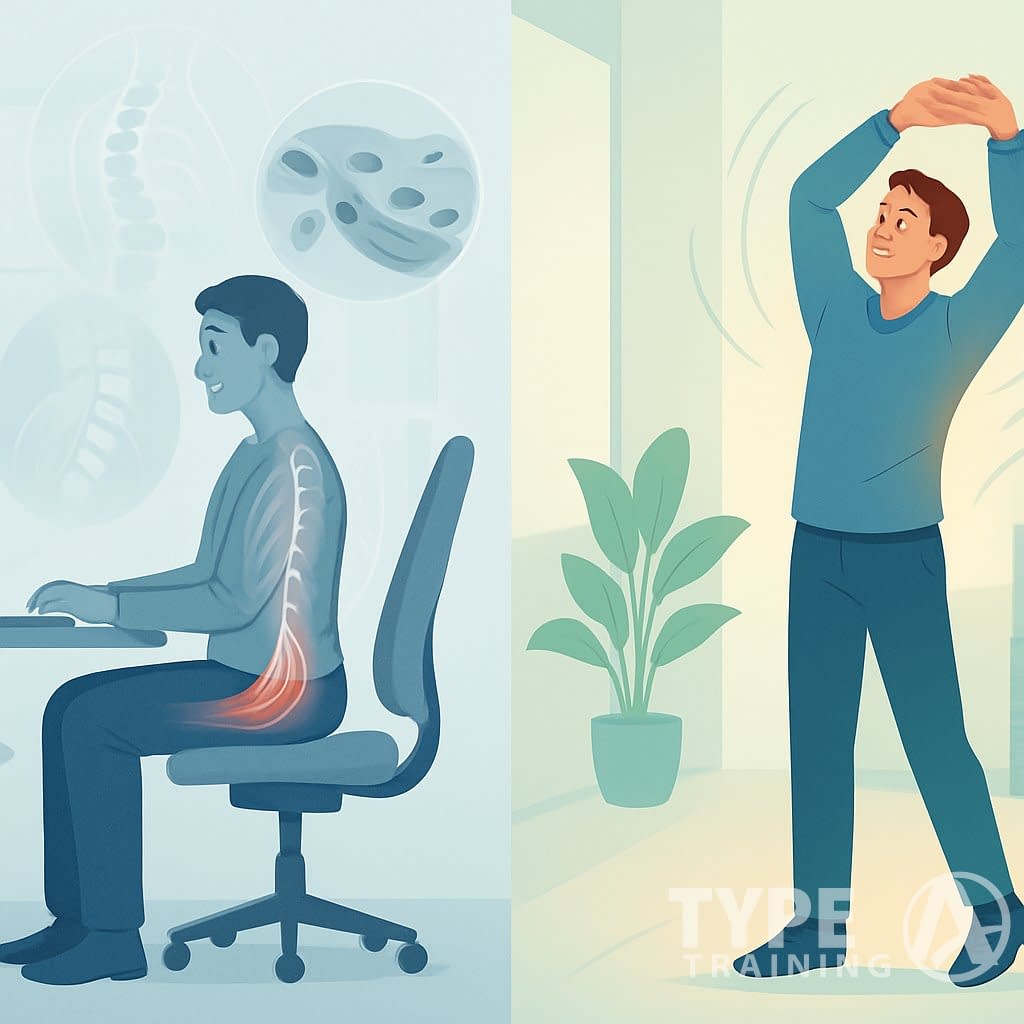
Modern work environments and lifestyle changes have led many people to spend most of their day sitting. This shift hits not just physical health but mental performance, too.
The effects of prolonged sitting often lead to complications that can impact daily life.
It creates new activity patterns that honestly deserve more attention.
What Constitutes Prolonged Sitting?
Prolonged sitting means staying in a seated position for long stretches without breaks. Research shows that sitting for more than 30 minutes at a time starts to trigger negative health responses.
Your body goes through changes during these long sitting periods. Blood flow drops, muscles go quiet, and your metabolism slows.
These things happen no matter how fit you are.
Key timeframes to keep in mind:
Understanding the effects of prolonged sitting is essential for reducing health risks.
- 30 minutes: First negative effects kick in
- 60 minutes: Blood glucose levels start to rise
- 2+ hours: Cardiovascular and metabolic impacts ramp up
The total time matters, but so does whether you move around. Sitting for three hours straight isn’t the same as sitting for three hours with regular breaks.
Modern Lifestyle and Sedentary Habits
Identifying the effects of prolonged sitting can help in creating a routine that minimizes risks.
Today’s work culture pushes us to sit more than ever before. Office jobs, remote work, and tech-based tasks keep people seated for 8 to 12 hours a day.
Transportation adds even more sitting time. Commuting by car, bus, or train stretches your sedentary period before and after work.
Many people sit during their commute, then sit all day at work.
Common daily sitting activities:
- Computer work and desk jobs
- Driving or commuting
- Watching TV
- Eating meals
- Using smartphones and tablets
Students have it tough, too, with classroom learning and study time. Online education has bumped up screen time and sitting for all ages.
The Rise of Actively Sedentary Lifestyles
Becoming aware of the effects of prolonged sitting can lead to healthier lifestyle changes.
A lot of people now fall into “actively sedentary” patterns. You might exercise for an hour but sit for the other 15 or 16 waking hours.
A morning workout doesn’t cancel out the effects of sitting all day. Research says prolonged sitting creates its own health risks—even if you meet your daily exercise goals.
This lifestyle is common among fitness-conscious folks. You run for 45 minutes, then sit at your desk for eight hours without moving much.
Actively sedentary traits:
- Regular, sometimes intense, exercise sessions
- Long blocks of uninterrupted sitting
- Not much movement during the workday
- Sedentary leisure activities
You need both daily physical activity and frequent movement breaks. Your body craves consistent activity, not just bursts of exercise followed by hours of inactivity.
Immediate Physical and Mental Effects of Extended Sitting
Your body and mind react quickly to long periods of sitting. These changes can show up within hours.
They can mess with your energy, blood flow, and even your mood.
Addressing the effects of prolonged sitting can enhance both physical and mental well-being.
Fatigue and Mental Fatigue
When you sit for a long time, your body works less efficiently. Muscles chill out, your metabolism slows, and energy production drops.
Mental fatigue creeps in as blood flow to your brain decreases. Your heart doesn’t need to pump as hard when you’re still.
You might notice:
-
- Trouble concentrating
- Slower thinking
Understanding the effects of prolonged sitting can help mitigate its negative impact.
- Feeling mentally foggy
- Struggling with problem-solving
Your executive functions take a hit. Decision-making, planning, and focus all get harder.
Studies show that cognitive performance drops during extended sitting.
Even simple tasks can feel like a slog after a while.
Anxiety and Stress
Sitting too long can ramp up feelings of anxiety and stress. Your body sees the lack of movement as a reason to conserve energy and stay alert for threats.
Recognizing the effects of prolonged sitting can improve your stress management strategies.
Sitting cuts down the production of mood-boosting chemicals like serotonin and endorphins. That makes it harder to feel calm or positive.
Physical tension builds in your neck, shoulders, and back. This tension sends stress signals to your brain.
Your breathing gets shallow, reducing oxygen flow. That can make you feel anxious or restless.
Many people notice more worry or nervousness after sitting for hours. It’s a cycle—stress makes you want to move less, and sitting makes you more stressed.
Impaired Blood Flow and Circulation
Poor circulation can start within 30 minutes of sitting. Your leg muscles stop contracting, so less blood returns to your heart.
Blood pools in your lower legs and feet, causing:
Awareness of the effects of prolonged sitting can motivate you to adopt healthier habits.
- Swelling in ankles and feet
- Numbness or tingling
- Cold hands and feet
- Higher risk of blood clots
Your heart rate slows, sending less oxygen-rich blood to your organs and brain.
Circulation problems hit your whole body. Your digestive system slows, making you feel sluggish after eating.
Less blood to your brain adds to mental fatigue and fuzzy thinking. This can show up after just an hour or two of non-stop sitting.
Understanding the effects of prolonged sitting allows for better lifestyle choices.
Short- and Long-Term Health Risks of a Sedentary Lifestyle
Sitting for long stretches puts your body at risk for both quick and lasting health problems. Muscles weaken, blood flow slows, and your metabolism changes in ways that raise your risk for disease.
Back Pain and Poor Posture
Poor posture sets in fast when you sit for hours without good support. Your spine curves the wrong way, and your back muscles and discs get extra stress.
Back pain can show up within days of ramped-up sitting. It usually starts in your lower back—the spot that takes the most weight.
Identifying the effects of prolonged sitting can aid in developing effective strategies.
Your hip flexors tighten while sitting, pulling on your lower back. Meanwhile, your glutes weaken from lack of use. This muscle imbalance only makes back pain worse.
Common posture problems from sitting:
-
- Forward head
- Rounded shoulders
- Curved upper back
- Tilted pelvis
Understanding the effects of prolonged sitting is key to maintaining health.
If you don’t do something about it, these changes can become permanent. Your body adapts to whatever position you spend the most time in.
Deep Vein Thrombosis and Circulatory Issues
Deep vein thrombosis (DVT) happens when blood clots form in the deep veins of your legs. Sitting for hours slows blood flow, making clots more likely.
DVT can cause leg swelling, pain, and warmth. If a clot breaks loose, it could travel to your lungs—a life-threatening situation.
Your circulation slows because your leg muscles aren’t pumping blood back to your heart. Pooling blood increases clot risk within hours of sitting.
Other circulation problems:
-
- Swollen ankles and feet
- Leg cramps
Recognizing the effects of prolonged sitting can help in preventing serious health issues.
- Varicose veins
- Blood clots
People who sit for over 4 hours at a time face higher DVT risk. Air travel makes this worse with cramped seats and cabin pressure.
Weight Gain and Diabetes
Weight gain happens faster when you’re sitting a lot. Your body burns fewer calories, and metabolism slows way down.
Sitting drops the activity of enzymes that break down fats—this starts within hours. It gets harder for your body to process what you eat.
Diabetes risk goes up with more sitting. Your muscles get less sensitive to insulin when they’re inactive.
Metabolic changes from sitting:
-
- 90% drop in fat-burning enzymes
Understanding the effects of prolonged sitting can enhance your overall health quality.
- 24% decrease in insulin effectiveness
- Slower glucose processing
- Less muscle glucose uptake
Your body starts storing more fat, especially around your waist. That belly fat can lead to type 2 diabetes and other metabolic problems.
Cardiovascular Disease and Chronic Diseases
Heart disease risk climbs with every extra hour you spend sitting. Your heart muscle weakens, and
Sitting for 6 or more hours daily doubles your risk of dying from cardiovascular disease. This risk stays high even if you exercise regularly.
Being aware of the effects of prolonged sitting can lead to better cardiovascular health.
Chronic diseases linked to too much sitting include cancer, osteoporosis, and depression. Your immune system doesn’t fight off illness as well, either.
Major disease risks from prolonged sitting:
- 147% higher risk of heart attack or stroke
- 112% higher diabetes risk
- 49% higher death rate from any cause
- Increased colon, breast, and lung cancer risk
Your blood chemistry shifts when you sit too long. Triglycerides rise, good cholesterol drops, and inflammation spreads through your body.
Understanding the effects of prolonged sitting is crucial for long-term health.
Evidence-Backed Strategies to Counteract Prolonged Sitting
Research shows that taking 5-minute walks every 30 minutes can reduce blood sugar and lower
Integrating Physical Activity Throughout the Day
Breaking up sitting with light activity works better than one long workout. Studies show that 5-minute walks every half hour lower blood glucose and
Set reminders on your phone or computer. Take phone calls while standing or walking if you can.
Easy ways to add movement:
Addressing the effects of prolonged sitting can significantly enhance your quality of life.
- Walk to a colleague’s desk instead of emailing
- Take stairs over elevators
- Park farther from entrances
- Get off public transport a stop early
Even just 1-minute movement breaks every hour help. Slow walking or gentle stretching absolutely count.
Your body loves frequent movement throughout the day. This approach beats being “actively sedentary”—one hard workout doesn’t erase hours of sitting.
Exercise Routines for the Sedentary
Specific exercise routines can target the muscle groups most affected by sitting too much. Focus on strengthening your core, glutes, and back muscles—those tend to get weak after hours at a desk.
Hip flexor stretches help loosen up tight muscles from sitting. Hold each stretch for about 30 seconds and repeat a couple of times daily.
Awareness of the effects of prolonged sitting empowers you to take action.
Glute bridges wake up those sleepy glute muscles. Try 15-20 reps during a quick work break.
Cat-cow stretches are great for your spine. Do 10-15 reps to help shake off back stiffness.
Wall push-ups give your upper body a little boost and can help with posture. Shoot for 10-15 reps.
Try to fit these exercises in two or three times throughout your workday. Most of them are easy enough to do in office clothes—no sweat required.
Standing Desk and Active Workspace Solutions
A standing desk lets you switch between sitting and standing during your workday. Start with 15-30 minutes of standing each hour, then slowly bump up the time if it feels good.
Key standing desk features:
-
- Adjustable height
Understanding the effects of prolonged sitting can lead to improved productivity.
- Monitor at eye level
- Keyboard at elbow height
- Anti-fatigue mat for your feet
Keep your posture in check. Stand with feet flat and shoulders relaxed. Don’t lock your knees or lean on one hip.
Active workspace ideas:
-
- Try a balance board
Recognizing the effects of prolonged sitting can inform your choices at work.
- Use a stability ball instead of a chair
- Under-desk elliptical machines
- Treadmill desks for walking meetings
Alternate between sitting and standing every half hour or so. Your body needs a little time to get used to standing more.
Regular Movement and Stretching Breaks
Schedule movement breaks so they become a habit. Set reminders every 30 minutes—otherwise, it’s way too easy to forget.
Being aware of the effects of prolonged sitting encourages consistent movement.
- Neck rolls to ease tension
- Shoulder shrugs to wake up your upper body
- Ankle circles for better circulation
- Spinal twists right in your chair
Take walking meetings when you can. Even a bathroom break is a chance to get your legs moving.
Movement break schedule:
Understanding the effects of prolonged sitting helps you maintain active habits.
- Every 30 minutes: Stand up and stretch for a couple of minutes
- Every hour: Take a 5-minute walk
- Every 2 hours: Do targeted exercises for 3-5 minutes
Track your breaks with a fitness app or just use a timer. It’s the consistency that matters, not intensity.
Practical Tips for Prevention and Long-Term Well-Being
Identifying the effects of prolonged sitting can create opportunities for change.
Breaking free from too much sitting takes some clever tweaks to your daily routine. You’ll need a bit of commitment to regular movement, but these strategies can help you build healthier habits at work and home.
Developing Healthy Work and Home Habits
How you set up your workspace really matters. Adjust your monitor to eye level to avoid neck pain. Keep your feet flat with knees bent at about 90 degrees.
Try a standing desk or a desk converter for part of the day. Start with 15-30 minutes of standing work and slowly increase the time if it feels okay.
Workspace habits that help:
-
- Take a 2-minute walk every 30 minutes
- Use a timer or phone app to remind you to move
Awareness of the effects of prolonged sitting can help you stay focused on health.
- Stand up for phone calls and video chats
- Park farther away or take the stairs
At home, avoid sitting for hours watching TV or scrolling on your phone. Stand up or stretch during commercials. Keep resistance bands nearby for quick bursts of movement.
Mindful Movement and Posture
Good posture makes a big difference for your spine and muscles. Sit with your back straight against the chair and shoulders relaxed—try not to hunch forward.
Work in simple desk exercises. Roll your shoulders back 10 times every hour. Slowly turn your head left and right to stretch your neck.
Quick movement ideas:
Understanding the effects of prolonged sitting can help manage stress levels.
- Do calf raises while standing
- Try seated spinal twists
- Ankle circles under your desk
- Deep breathing with a shoulder blade squeeze
Watch your posture when you’re moving, too. Walk with your head up and shoulders back. During exercise, keep your form solid to avoid injury.
Reducing Sedentary Time and Tracking Progress
Track your sitting time with a fitness tracker or your phone. Try to cut back by 30 minutes a day over a few weeks.
Taking breaks from the effects of prolonged sitting can boost overall well-being.
Swap out some sitting for active options. Stand up while reading emails or take walking meetings. Use a stability ball as a chair now and then.
Daily movement goals:
- 8,000-10,000 steps per day
- 30 minutes of physical activity
- Stand up every 30-60 minutes
- Strength training 2-3 times a week
Check your progress every week. Notice if your energy, back pain, or sleep improve. Tweak your routine as needed—life changes, and so should your habits.
Recognizing the effects of prolonged sitting can empower positive lifestyle changes.
Improving Mental Health and Quality of Life
Understanding the effects of prolonged sitting is vital for ensuring overall well-being.
Breaking up long stretches of sitting can help fight anxiety and depression. It also sharpens your focus and boosts work performance. Regular movement breaks lower stress hormones and increase blood flow to your brain, which just makes you feel better.
Adopting strategies to mitigate the effects of prolonged sitting can improve life quality.
Addressing Depression and Mood Disorders
Sitting for hours on end raises your risk of anxiety and depression. People who sit more than 8 hours a day see about 20% higher rates of these issues.
Awareness of the effects of prolonged sitting is essential for mental well-being.
How movement breaks help:
-
- They trigger endorphins and lift your mood
Understanding the effects of prolonged sitting can improve your day-to-day life.
- Lower stress hormone (cortisol) levels
- Boost blood flow to the brain
- Give you a chance to interact with others
You can fight these effects with small changes. Stand and walk for 2-3 minutes every half hour. Take phone calls while walking if you can.
Quick mood boosters:
-
- Desk stretches
- Short walks outside
Awareness of the effects of prolonged sitting can enhance mood and focus.
-
- Standing meetings
Understanding the effects of prolonged sitting can empower you to make necessary lifestyle changes.
- Taking stairs instead of elevators
Even five minutes of light movement every hour can cut anxiety symptoms by 15%. Your posture matters, too—hunching over just makes you feel worse.
Try setting reminders on your phone to move. These little breaks help keep stress from building up.
Supporting Cognitive Health and Productivity
Mental fatigue from sitting too long makes it hard to focus. Your brain needs steady blood flow and oxygen to work well.
Sitting for hours can cut blood flow to your brain by up to 20%. That means:
Addressing the effects of prolonged sitting contributes to mental clarity.
- You lose focus
- Your reaction time slows
- Memory gets fuzzy
- Creativity drops
Movement breaks help your brain by:
-
- Increasing blood flow upstairs
Understanding the effects of prolonged sitting can lead to healthier environments.
- Boosting oxygen delivery
- Releasing BDNF (a brain growth factor)
- Reducing inflammation
Just standing or walking for two minutes can bring blood flow back to normal. You’ll think more clearly and stay alert.
People who take regular movement breaks are about 23% more productive. They make fewer mistakes and solve problems better.
Even simple stuff—like stretching or walking to get water—can reset your mental energy. These breaks help you avoid that dreaded afternoon brain fog.
Recognizing the effects of prolonged sitting is essential in today’s work culture.
Alternating between sitting and standing keeps your mind sharper all day.
Frequently Asked Questions
Lots of folks have questions about managing the health risks of sitting too much. Here are some practical answers about desk setup, break timing, exercises, heart health, standing desks, and habits that support a more active lifestyle.
What are the best ergonomic practices to reduce strain from sitting all day?
Put your monitor at eye level to keep your neck happy. Keep the screen about arm’s length away.
Understanding the effects of prolonged sitting can help prevent serious health issues.
Make sure your feet are flat on the floor and your knees bend at a right angle. If your feet dangle, grab a footrest.
Set your chair so your elbows are at 90 degrees when you type. Keep your wrists straight, not bent.
Keep the keyboard and mouse close so you’re not reaching. This helps your shoulders relax.
Pick a chair that supports your lower back’s natural curve. If it doesn’t, toss a small pillow behind you.
How frequently should one take breaks from sitting to mitigate health risks?
Stand up and move for 5 minutes after every hour of sitting. That’s a good target for most people.
Use these breaks to walk or stretch a bit. Even a little movement gets your blood flowing.
Set phone or computer reminders so you don’t forget. Lots of fitness trackers buzz if you’ve been sitting too long.
Short, regular breaks beat long, infrequent ones. Your body needs steady movement throughout the day.
Awareness about the effects of prolonged sitting is key to fostering a healthier lifestyle.
Can you suggest a routine of stretches or exercises to counteract sitting for long hours?
Hip flexor stretches loosen up tight hips from sitting. Step one foot forward into a lunge and hold for 30 seconds per side.
Strengthen your glutes with bridges. Lie down, bend your knees, and lift your hips for 15-20 reps.
Do cat-cow stretches for your spine. On hands and knees, alternate arching and rounding your back.
Try neck rolls at your desk and shoulder shrugs. Roll your shoulders back 10 times to ease tension.
Calf raises while standing help your legs. Rise up on your toes and lower down slowly for 15-20 reps.
What is the impact of prolonged sitting on cardiovascular health?
Sitting for 6-8 hours (or more) every day bumps up your risk of heart problems by 125% to 150%. That’s about as risky as smoking or being obese.
Understanding the effects of prolonged sitting can enhance cardiovascular health.
Long sitting stretches raise
Your heart just doesn’t work as efficiently when you sit for ages. Regular movement keeps your cardiovascular system in better shape.
How does the use of a standing desk benefit those who sit extensively for work?
Standing desks can help you burn about 170 more calories per day than sitting. That adds up over time.
Standing also works your core and helps you keep better posture. Your body stays more active, instead of just slumping in a chair.
You’ll probably notice better focus and mental clarity since blood flows more easily when you stand.
Being aware of the effects of prolonged sitting can motivate you to stay active.
But don’t stand all day—too much standing can make your muscles and joints ache. Mix it up: sit, stand, move around. That’s the sweet spot.
What dietary recommendations support a lifestyle with significant sedentary periods?
Focus on foods that fight inflammation. Prolonged sitting tends to bump up inflammatory markers, so toss some berries, leafy greens, and fatty fish onto your plate.
Choose foods that help keep blood sugar steady. Sitting too much can raise your diabetes risk, so try swapping in whole grains and cutting back on the processed stuff.
Keep a water bottle handy and sip throughout the day. Hydration really supports circulation, which sitting tends to slow down.
Eat smaller, more frequent meals to keep your energy from tanking. Big meals plus long stretches in a chair? That combo just makes you feel sluggish.
Add foods high in potassium like bananas and sweet potatoes. Potassium can help balance out the
The effects of prolonged sitting can lead to various health concerns that should not be ignored.
impact from all that sitting.

